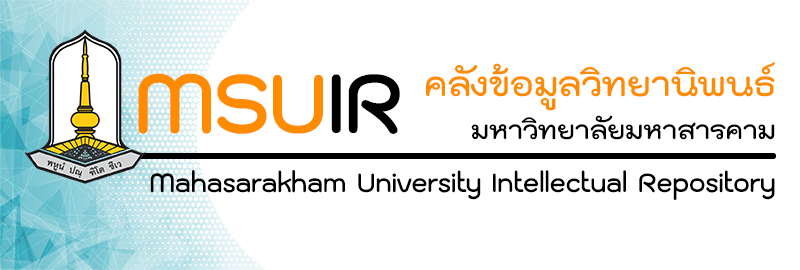Please use this identifier to cite or link to this item:
http://202.28.34.124/dspace/handle123456789/2892Full metadata record
| DC Field | Value | Language |
|---|---|---|
| dc.contributor | Waraporn Seubchompu | en |
| dc.contributor | วราภรณ์ สืบชมภู | th |
| dc.contributor.advisor | Juntip Kanjanasilp | en |
| dc.contributor.advisor | จันทร์ทิพย์ กาญจนศิลป์ | th |
| dc.contributor.other | Mahasarakham University | en |
| dc.date.accessioned | 2025-05-07T11:50:41Z | - |
| dc.date.available | 2025-05-07T11:50:41Z | - |
| dc.date.created | 2024 | |
| dc.date.issued | 18/6/2024 | |
| dc.identifier.uri | http://202.28.34.124/dspace/handle123456789/2892 | - |
| dc.description.abstract | Objective: To develop an assessment tool for factors related to warfarin adherence issues in individual patients, aiming to resolve non-adherence problems through pharmacist interventions to ensure therapeutic outcomes within the normal range Methodology: The study is divided into two parts: Design and Development of the Assessment Tool: The goal is to identify factors affecting warfarin adherence.The assessment tool is utilized to collect data and identify issues across various domains, including socio-economic factors, healthcare system factors, related conditions, treatment protocols, and patient-specific factors. This part involves all patients who are non-adherent to their warfarin regimen. Intervention and Problem-Solving: Address the identified adherence issues in individual patients through various interventions: Educating patients about warfarin use by pharmacists.Utilizing smart medication labels and reminder boxes.Implementing phone call reminders for medication adherence. Measure and compare adherence outcomes by evaluating: Adherence to warfarin as prescribed by the physician (reduction in missed doses).Pill count to determine % adherence.Patient knowledge regarding warfarin use.Percent Time in Therapeutic Range (TTR).Adverse effects from warfarin use before and after the intervention.Results: The developed assessment tool identified factors related to warfarin adherence issues with an IOC (Index of Item-Objective Congruence) of 0.9 and a reliability level of 0.95 (Kuder-Richardson 20). Upon implementing the assessment and addressing the identified issues, the following outcomes were observed: Patient Knowledge: Average knowledge scores before and after pharmaceutical care intervention were 11.03 and 14.10, respectively (p-value < 0.001). Adherence Rates: Non-adherence due to missed doses decreased significantly from 54.4% to 20.6% (p-value < 0.001). Adherence based on pill count increased from 90.9% to 96.85% (p-value < 0.001). Adverse Effects: Incidences of adverse effects from warfarin use before and after the intervention were 10 and 7, respectively (p = 0.405). Conclusion: The study concludes that identifying and addressing patient-specific adherence issues leads to improved patient knowledge and higher adherence to warfarin therapy as prescribed by physicians. | en |
| dc.description.abstract | วัตถุประสงค์: เพื่อพัฒนาแบบประเมินปัจจัยที่เกี่ยวข้องกับปัญหาความร่วมมือในการใช้ยาวาร์ฟารินของผู้ป่วยเฉพาะราย เพื่อแก้ไขปัญหาความไม่ร่วมมือในการใช้ยาวาร์ฟาริน (medication adherence) โดยการให้คำปรึกษาและดูแลโดยเภสัชกร (pharmacist intervention) สำหรับผู้ป่วยเฉพาะราย เพื่อให้ผลการรักษาอยู่ในเกณฑ์ปกติ วิธีการ: การศึกษานี้แบ่งออกเป็น 2 ส่วน คือ ออกแบบและพัฒนาแบบประเมินเพื่อค้นหาปัจจัยที่มีผลต่อความร่วมมือในการใช้ยาวาร์ฟาริน นำแบบประเมินมาใช้เพื่อเก็บข้อมูล และค้นหาปัญหาในด้านต่าง ๆ ได้แก่ ปัจจัยทางสังคม/เศรษฐศาสตร์ ปัจจัยด้านระบบการดูแลสุขภาพ เงื่อนไขต่าง ๆ ที่สัมพันธ์ แนวทางการรักษา ปัจจัยด้านตัวผู้ป่วย โดยดำเนินการกับผู้ป่วยทุกรายที่ไม่ร่วมมือในการใช้ยาวาร์ฟาริน ส่วนที่ 2 ดำเนินการแก้ไขปัญหาความไม่ร่วมมือในการใช้ยาวาร์ฟารินด้านต่างๆ ที่พบในผู้ป่วยเฉพาะราย โดยการให้ความรู้เกี่ยวกับการใช้ยาวาร์ฟารินโดยเภสัชกร การใช้ฉลากยาอัจฉริยะและกล่องเตือนการใช้ยา การเตือนการใช้ยาทางโทรศัพท์ แล้ววัดผลเปรียบเทียบ ความร่วมมือในการใช้ยาวาร์ฟารินตามคำสั่งแพทย์โดยไม่ปฏิบัติตามคำสั่งแพทย์(ลืมรับประทานยา) การนับเม็ดยาที่เหลือของผู้ป่วย(% adherence) ประเมินความรู้ในการใช้ยาวาร์ฟาริน ค่า Percent Time in therapeutic range (TTR) อาการไม่พึงประสงค์จากการใช้ยาวาร์ฟาริน ก่อนและหลังการแก้ไขปัญหา ผลการวิจัย: ได้แบบประเมินปัญหาที่สัมพันธ์กับความร่วมมือในการใช้ยาวาร์ฟารินในด้านต่างๆ ของผู้ป่วยที่มีค่า IOC เท่ากับ 0.9 และมีระดับความเชื่อมั่น เท่ากับ 0.95 (Kuder – Richardson 20) หลังจากนำใช้แบบประเมินเพื่อค้นหาปัญหา และแก้ไขปัญหาตามแนวทาง ได้ผลดังนี้ คะแนนความรู้เฉลี่ยก่อนและหลังการให้การบริบาลทางเภสัชกรรม เท่ากับ 11.03 และ 14.10 (p – value < 0.001) ความร่วมมือในการใช้ยาวาร์ฟารินตามคำสั่งแพทย์โดยไม่ปฏิบัติตามคำสั่งแพทย์(ลืมรับประทานยา) ลดลงจากร้อยละ 54.4 เป็น 20.6 อย่างมีนัยสำคัญ (p – value < 0.001) ความร่วมมือในการใช้ยาวาร์ฟารินตามคำสั่งแพทย์ด้วยการนับเม็ดยาที่เหลือของผู้ป่วย (% adherence) เท่ากับ ร้อยละ 90.9 และ 96.85 (p – value < 0.001) และเกิดอุบัติการณ์อาการไม่พึงประสงค์จากการใช้ยาวาร์ฟารินของผู้ป่วยก่อนและหลังการแก้ไขปัญหาเท่ากับ 10 และ 7 ครั้ง ตามลำดับ(p= 0.405) สรุป: ผลการวิจัยพบว่าการค้นหาปัญหาและการแก้ไขปัญหาผู้ป่วยเฉพาะราย ส่งผลให้ผู้ป่วยมีความรู้ในการใช้ยาวาร์ฟารินเพิ่มขึ้น มีความร่วมมือในการใช้ยาวาร์ฟารินตามคำสั่งแพทย์สูงขึ้น | th |
| dc.language.iso | th | |
| dc.publisher | Mahasarakham University | |
| dc.rights | Mahasarakham University | |
| dc.subject | ปัญหาเฉพาะราย | th |
| dc.subject | วาร์ฟาริน | th |
| dc.subject | Individualized Problems | en |
| dc.subject | Warfarin | en |
| dc.subject.classification | Health Professions | en |
| dc.subject.classification | Education | en |
| dc.title | Individual intervention for improving adherence in patient treated with warfarin | en |
| dc.title | การแก้ไขปัญหาผู้ป่วยเฉพาะรายเพื่อเพิ่มความร่วมมือในการใช้ยาวาร์ฟาริน | th |
| dc.type | Thesis | en |
| dc.type | วิทยานิพนธ์ | th |
| dc.contributor.coadvisor | Juntip Kanjanasilp | en |
| dc.contributor.coadvisor | จันทร์ทิพย์ กาญจนศิลป์ | th |
| dc.contributor.emailadvisor | juntip.k@msu.ac.th | |
| dc.contributor.emailcoadvisor | juntip.k@msu.ac.th | |
| dc.description.degreename | Master of Pharmacy (M.Pharm.) | en |
| dc.description.degreename | เภสัชศาสตรมหาบัณฑิต (ภ.ม.) | th |
| dc.description.degreelevel | Master's Degree | en |
| dc.description.degreelevel | ปริญญาโท | th |
| dc.description.degreediscipline | สาขาวิชาเภสัชศาสตร์ | en |
| dc.description.degreediscipline | สาขาวิชาเภสัชศาสตร์ | th |
| Appears in Collections: | The Faculty of Pharmacy | |
Files in This Item:
| File | Description | Size | Format | |
|---|---|---|---|---|
| 61010780003.pdf | 1.51 MB | Adobe PDF | View/Open |
Items in DSpace are protected by copyright, with all rights reserved, unless otherwise indicated.

